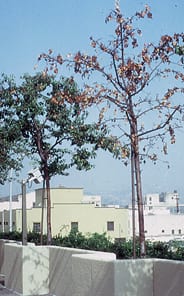Erwinia amylovora (bacterium)
Hosts include many species of the rose family, including apple, amelanchier, cherry, crabapple, hawthorn, mountain ash, pear, plum, and pyracantha. Found throughout the continental United States and southern Canada.
Contributors include cool, wet weather or fog; infected nursery stock or grafting stock; overhead sprinkler irrigation; over-fertilization.
In late spring, blossoms, young leaves, and shoots suddenly wilt. Infected areas of tree first appear water-soaked, then quickly turn brown to black, appearing as if burned by fire. The infection may progress down a shoot or small branch and start a stem canker in a larger branch or stem. The inner bark of these cankered areas is water-soaked, turning green to brown. The surface withers and wrinkles. In warm, wet weather, milky ooze may appear on infected bark, attracting insects. Cankers may girdle branches or the main trunk killing the tree. Dead leaves remain attached to dead branches.
The bacterium overwinters at edges of cankers and on blighted twigs, becoming active during warm spring rains. Ooze is produced on twigs and cankers, attracting numerous insects which may carry the pathogen to the foliage, twigs, and blossoms of healthy trees. Bacteria may also be carried by contaminated pruning tools, or by dripping water or splashing rain from the ooze to healthy tissues below. The pathogen generally enters the tree through wounds, natural openings in the leaves, or through flower parts. Infections enlarge until spring growth stops, about a month after blossoming. Bacteria in infected tissues lie dormant in late summer and remains so until the following spring.


